Stakeholder Analysis for Snap Inc.: Identifying Key Stakeholders and Generic Strategies
VerifiedAdded on 2023/06/07
|11
|2850
|225
AI Summary
This paper provides a stakeholder analysis for Snap Inc., identifying key stakeholders and generic strategies for each category. It outlines the organizational model and the role of stakeholders in the company's success. The stakeholders discussed include customers, suppliers, media, employees, competitors, and owners. The paper also provides recommendations for each stakeholder category.
Contribute Materials
Your contribution can guide someone’s learning journey. Share your
documents today.

Running head: Stakeholder analysis
Stakeholder analysis
Stakeholder analysis
Secure Best Marks with AI Grader
Need help grading? Try our AI Grader for instant feedback on your assignments.
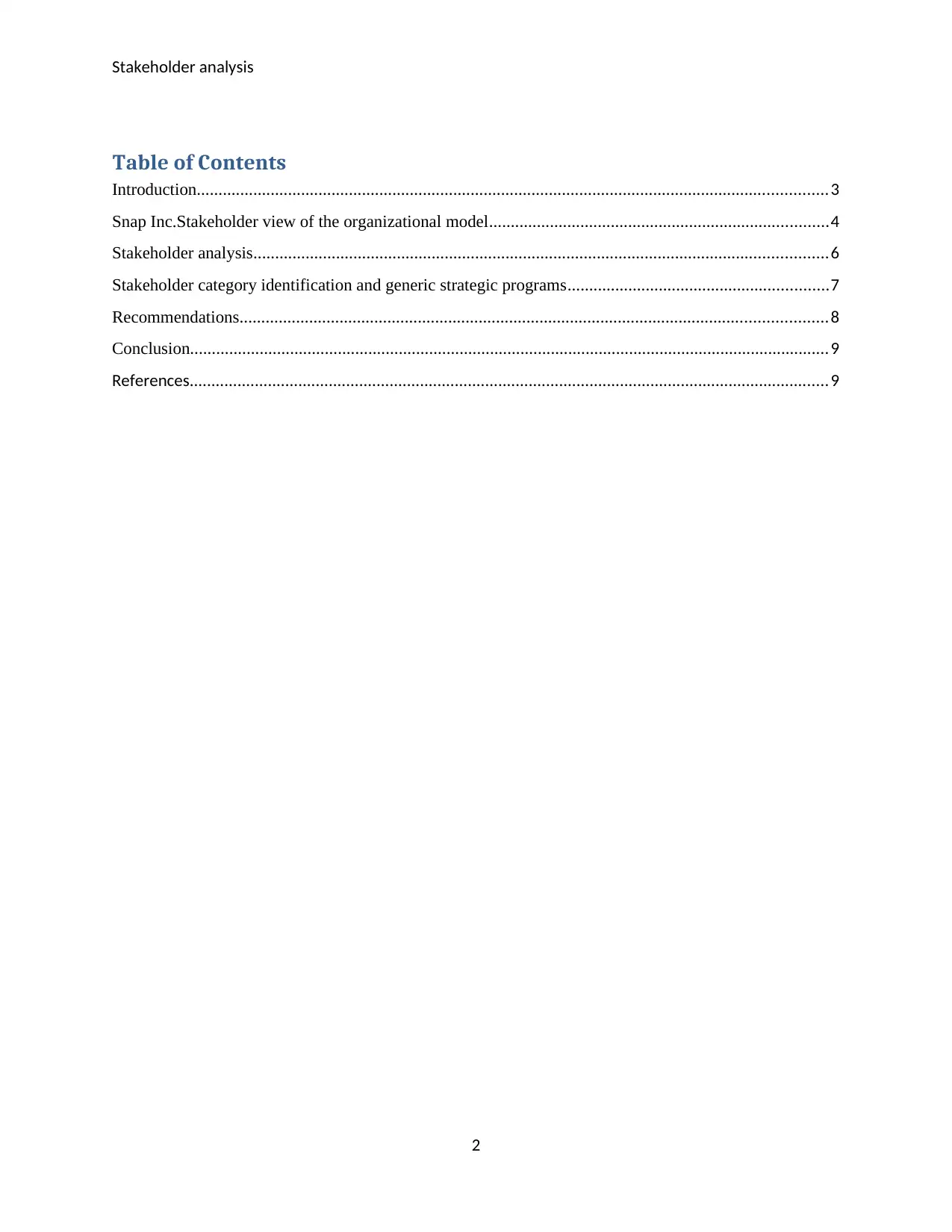
Stakeholder analysis
Table of Contents
Introduction.................................................................................................................................................3
Snap Inc.Stakeholder view of the organizational model..............................................................................4
Stakeholder analysis....................................................................................................................................6
Stakeholder category identification and generic strategic programs............................................................7
Recommendations.......................................................................................................................................8
Conclusion...................................................................................................................................................9
References...................................................................................................................................................9
2
Table of Contents
Introduction.................................................................................................................................................3
Snap Inc.Stakeholder view of the organizational model..............................................................................4
Stakeholder analysis....................................................................................................................................6
Stakeholder category identification and generic strategic programs............................................................7
Recommendations.......................................................................................................................................8
Conclusion...................................................................................................................................................9
References...................................................................................................................................................9
2
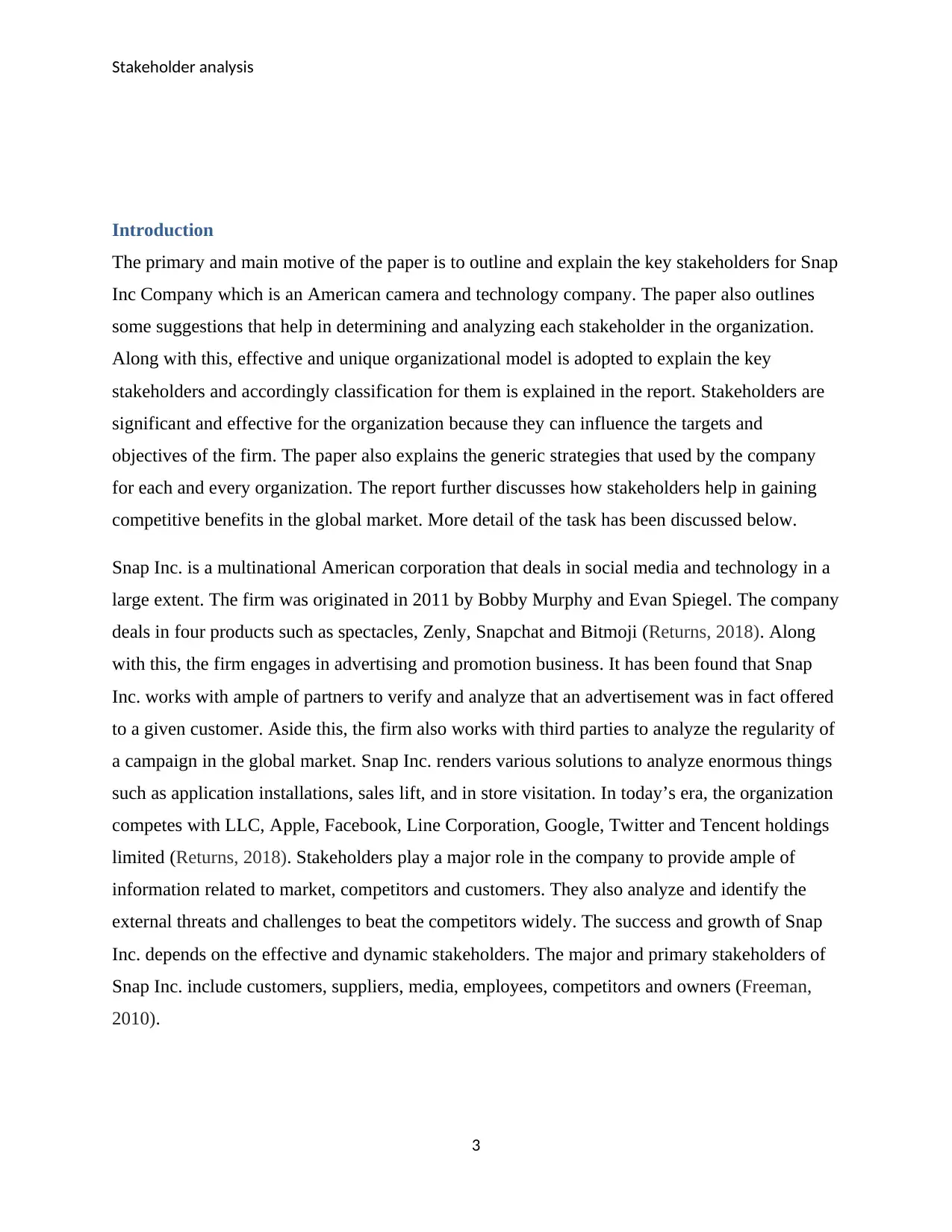
Stakeholder analysis
Introduction
The primary and main motive of the paper is to outline and explain the key stakeholders for Snap
Inc Company which is an American camera and technology company. The paper also outlines
some suggestions that help in determining and analyzing each stakeholder in the organization.
Along with this, effective and unique organizational model is adopted to explain the key
stakeholders and accordingly classification for them is explained in the report. Stakeholders are
significant and effective for the organization because they can influence the targets and
objectives of the firm. The paper also explains the generic strategies that used by the company
for each and every organization. The report further discusses how stakeholders help in gaining
competitive benefits in the global market. More detail of the task has been discussed below.
Snap Inc. is a multinational American corporation that deals in social media and technology in a
large extent. The firm was originated in 2011 by Bobby Murphy and Evan Spiegel. The company
deals in four products such as spectacles, Zenly, Snapchat and Bitmoji (Returns, 2018). Along
with this, the firm engages in advertising and promotion business. It has been found that Snap
Inc. works with ample of partners to verify and analyze that an advertisement was in fact offered
to a given customer. Aside this, the firm also works with third parties to analyze the regularity of
a campaign in the global market. Snap Inc. renders various solutions to analyze enormous things
such as application installations, sales lift, and in store visitation. In today’s era, the organization
competes with LLC, Apple, Facebook, Line Corporation, Google, Twitter and Tencent holdings
limited (Returns, 2018). Stakeholders play a major role in the company to provide ample of
information related to market, competitors and customers. They also analyze and identify the
external threats and challenges to beat the competitors widely. The success and growth of Snap
Inc. depends on the effective and dynamic stakeholders. The major and primary stakeholders of
Snap Inc. include customers, suppliers, media, employees, competitors and owners (Freeman,
2010).
3
Introduction
The primary and main motive of the paper is to outline and explain the key stakeholders for Snap
Inc Company which is an American camera and technology company. The paper also outlines
some suggestions that help in determining and analyzing each stakeholder in the organization.
Along with this, effective and unique organizational model is adopted to explain the key
stakeholders and accordingly classification for them is explained in the report. Stakeholders are
significant and effective for the organization because they can influence the targets and
objectives of the firm. The paper also explains the generic strategies that used by the company
for each and every organization. The report further discusses how stakeholders help in gaining
competitive benefits in the global market. More detail of the task has been discussed below.
Snap Inc. is a multinational American corporation that deals in social media and technology in a
large extent. The firm was originated in 2011 by Bobby Murphy and Evan Spiegel. The company
deals in four products such as spectacles, Zenly, Snapchat and Bitmoji (Returns, 2018). Along
with this, the firm engages in advertising and promotion business. It has been found that Snap
Inc. works with ample of partners to verify and analyze that an advertisement was in fact offered
to a given customer. Aside this, the firm also works with third parties to analyze the regularity of
a campaign in the global market. Snap Inc. renders various solutions to analyze enormous things
such as application installations, sales lift, and in store visitation. In today’s era, the organization
competes with LLC, Apple, Facebook, Line Corporation, Google, Twitter and Tencent holdings
limited (Returns, 2018). Stakeholders play a major role in the company to provide ample of
information related to market, competitors and customers. They also analyze and identify the
external threats and challenges to beat the competitors widely. The success and growth of Snap
Inc. depends on the effective and dynamic stakeholders. The major and primary stakeholders of
Snap Inc. include customers, suppliers, media, employees, competitors and owners (Freeman,
2010).
3
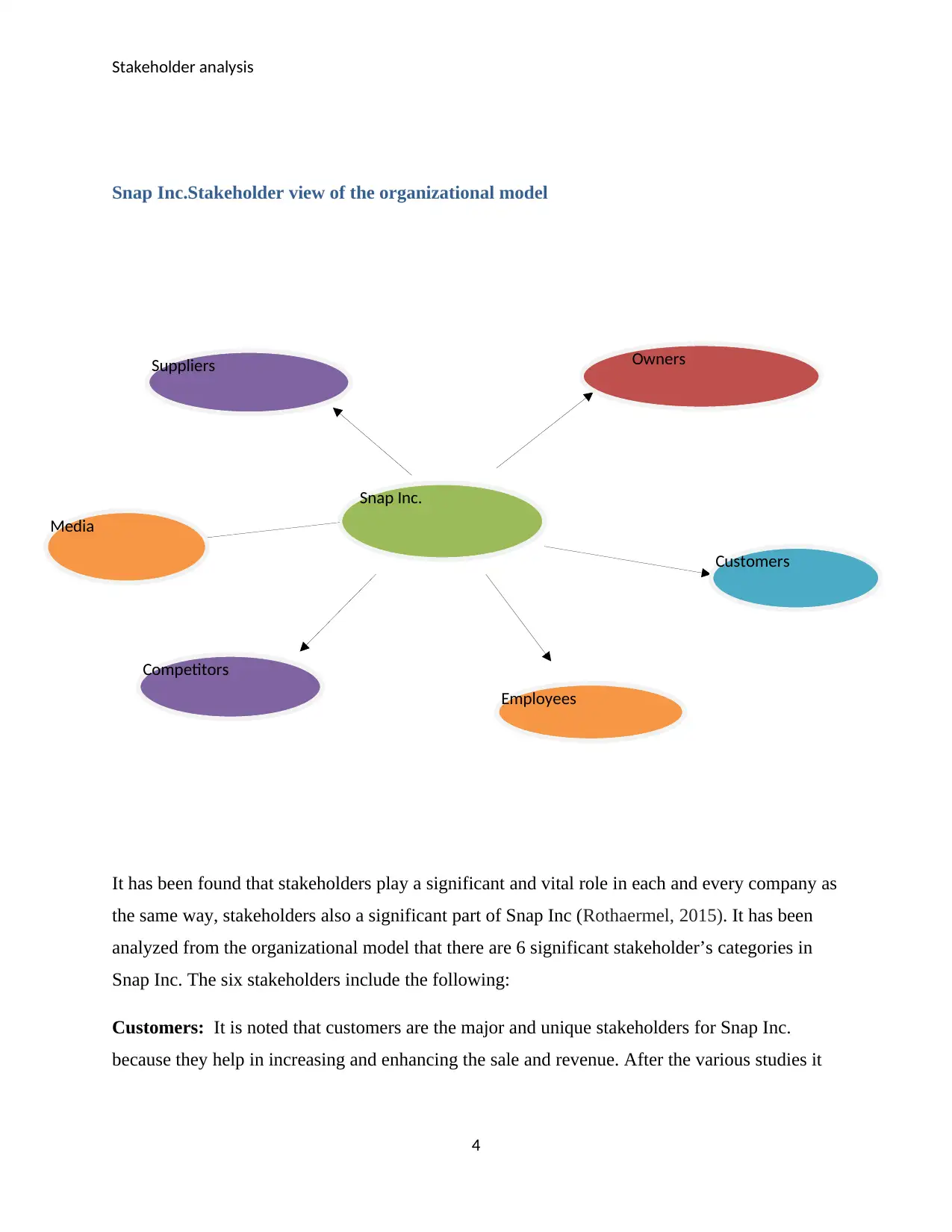
Stakeholder analysis
Snap Inc.Stakeholder view of the organizational model
It has been found that stakeholders play a significant and vital role in each and every company as
the same way, stakeholders also a significant part of Snap Inc (Rothaermel, 2015). It has been
analyzed from the organizational model that there are 6 significant stakeholder’s categories in
Snap Inc. The six stakeholders include the following:
Customers: It is noted that customers are the major and unique stakeholders for Snap Inc.
because they help in increasing and enhancing the sale and revenue. After the various studies it
4
Snap Inc.
Owners
Customers
Suppliers
Media
Competitors
Employees
Snap Inc.Stakeholder view of the organizational model
It has been found that stakeholders play a significant and vital role in each and every company as
the same way, stakeholders also a significant part of Snap Inc (Rothaermel, 2015). It has been
analyzed from the organizational model that there are 6 significant stakeholder’s categories in
Snap Inc. The six stakeholders include the following:
Customers: It is noted that customers are the major and unique stakeholders for Snap Inc.
because they help in increasing and enhancing the sale and revenue. After the various studies it
4
Snap Inc.
Owners
Customers
Suppliers
Media
Competitors
Employees
Secure Best Marks with AI Grader
Need help grading? Try our AI Grader for instant feedback on your assignments.
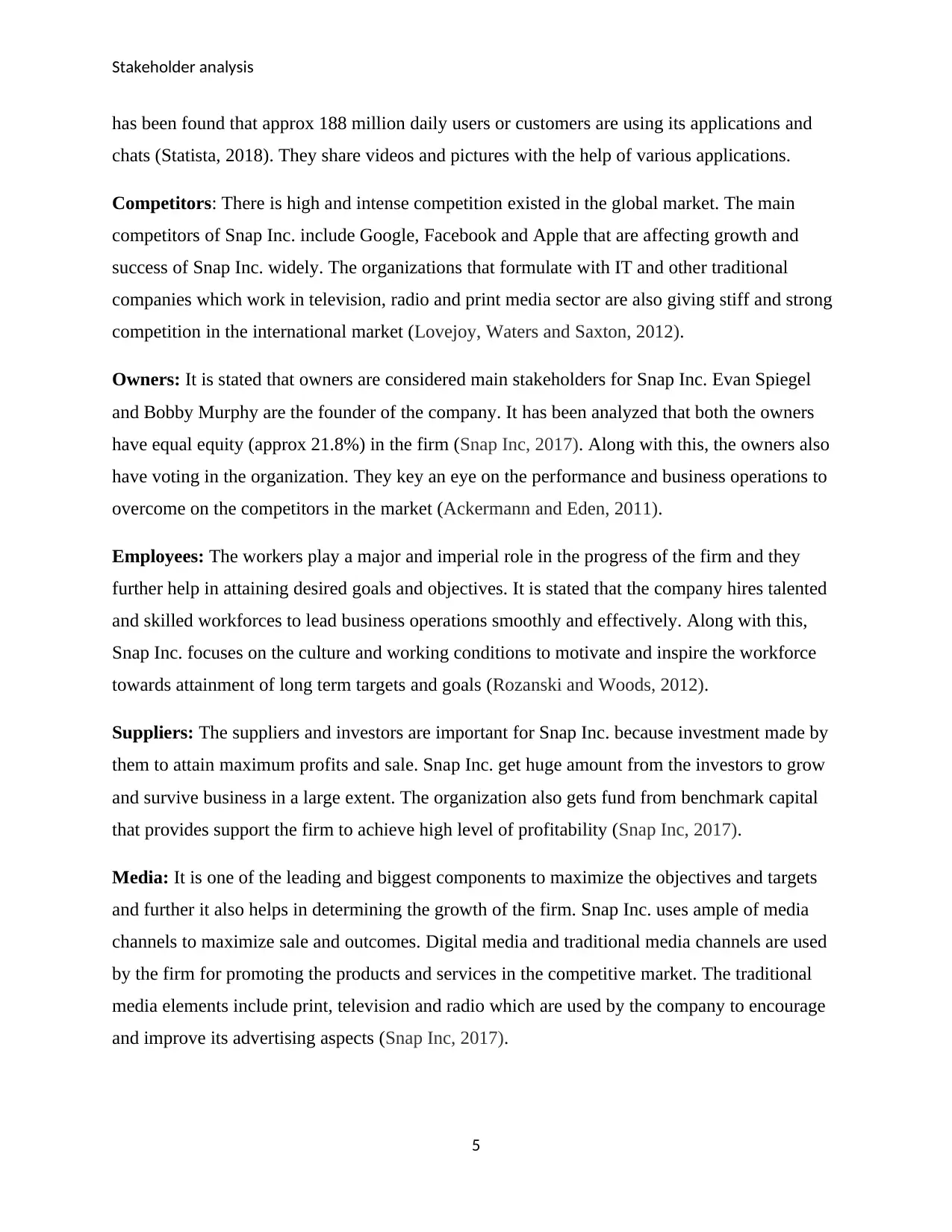
Stakeholder analysis
has been found that approx 188 million daily users or customers are using its applications and
chats (Statista, 2018). They share videos and pictures with the help of various applications.
Competitors: There is high and intense competition existed in the global market. The main
competitors of Snap Inc. include Google, Facebook and Apple that are affecting growth and
success of Snap Inc. widely. The organizations that formulate with IT and other traditional
companies which work in television, radio and print media sector are also giving stiff and strong
competition in the international market (Lovejoy, Waters and Saxton, 2012).
Owners: It is stated that owners are considered main stakeholders for Snap Inc. Evan Spiegel
and Bobby Murphy are the founder of the company. It has been analyzed that both the owners
have equal equity (approx 21.8%) in the firm (Snap Inc, 2017). Along with this, the owners also
have voting in the organization. They key an eye on the performance and business operations to
overcome on the competitors in the market (Ackermann and Eden, 2011).
Employees: The workers play a major and imperial role in the progress of the firm and they
further help in attaining desired goals and objectives. It is stated that the company hires talented
and skilled workforces to lead business operations smoothly and effectively. Along with this,
Snap Inc. focuses on the culture and working conditions to motivate and inspire the workforce
towards attainment of long term targets and goals (Rozanski and Woods, 2012).
Suppliers: The suppliers and investors are important for Snap Inc. because investment made by
them to attain maximum profits and sale. Snap Inc. get huge amount from the investors to grow
and survive business in a large extent. The organization also gets fund from benchmark capital
that provides support the firm to achieve high level of profitability (Snap Inc, 2017).
Media: It is one of the leading and biggest components to maximize the objectives and targets
and further it also helps in determining the growth of the firm. Snap Inc. uses ample of media
channels to maximize sale and outcomes. Digital media and traditional media channels are used
by the firm for promoting the products and services in the competitive market. The traditional
media elements include print, television and radio which are used by the company to encourage
and improve its advertising aspects (Snap Inc, 2017).
5
has been found that approx 188 million daily users or customers are using its applications and
chats (Statista, 2018). They share videos and pictures with the help of various applications.
Competitors: There is high and intense competition existed in the global market. The main
competitors of Snap Inc. include Google, Facebook and Apple that are affecting growth and
success of Snap Inc. widely. The organizations that formulate with IT and other traditional
companies which work in television, radio and print media sector are also giving stiff and strong
competition in the international market (Lovejoy, Waters and Saxton, 2012).
Owners: It is stated that owners are considered main stakeholders for Snap Inc. Evan Spiegel
and Bobby Murphy are the founder of the company. It has been analyzed that both the owners
have equal equity (approx 21.8%) in the firm (Snap Inc, 2017). Along with this, the owners also
have voting in the organization. They key an eye on the performance and business operations to
overcome on the competitors in the market (Ackermann and Eden, 2011).
Employees: The workers play a major and imperial role in the progress of the firm and they
further help in attaining desired goals and objectives. It is stated that the company hires talented
and skilled workforces to lead business operations smoothly and effectively. Along with this,
Snap Inc. focuses on the culture and working conditions to motivate and inspire the workforce
towards attainment of long term targets and goals (Rozanski and Woods, 2012).
Suppliers: The suppliers and investors are important for Snap Inc. because investment made by
them to attain maximum profits and sale. Snap Inc. get huge amount from the investors to grow
and survive business in a large extent. The organization also gets fund from benchmark capital
that provides support the firm to achieve high level of profitability (Snap Inc, 2017).
Media: It is one of the leading and biggest components to maximize the objectives and targets
and further it also helps in determining the growth of the firm. Snap Inc. uses ample of media
channels to maximize sale and outcomes. Digital media and traditional media channels are used
by the firm for promoting the products and services in the competitive market. The traditional
media elements include print, television and radio which are used by the company to encourage
and improve its advertising aspects (Snap Inc, 2017).
5
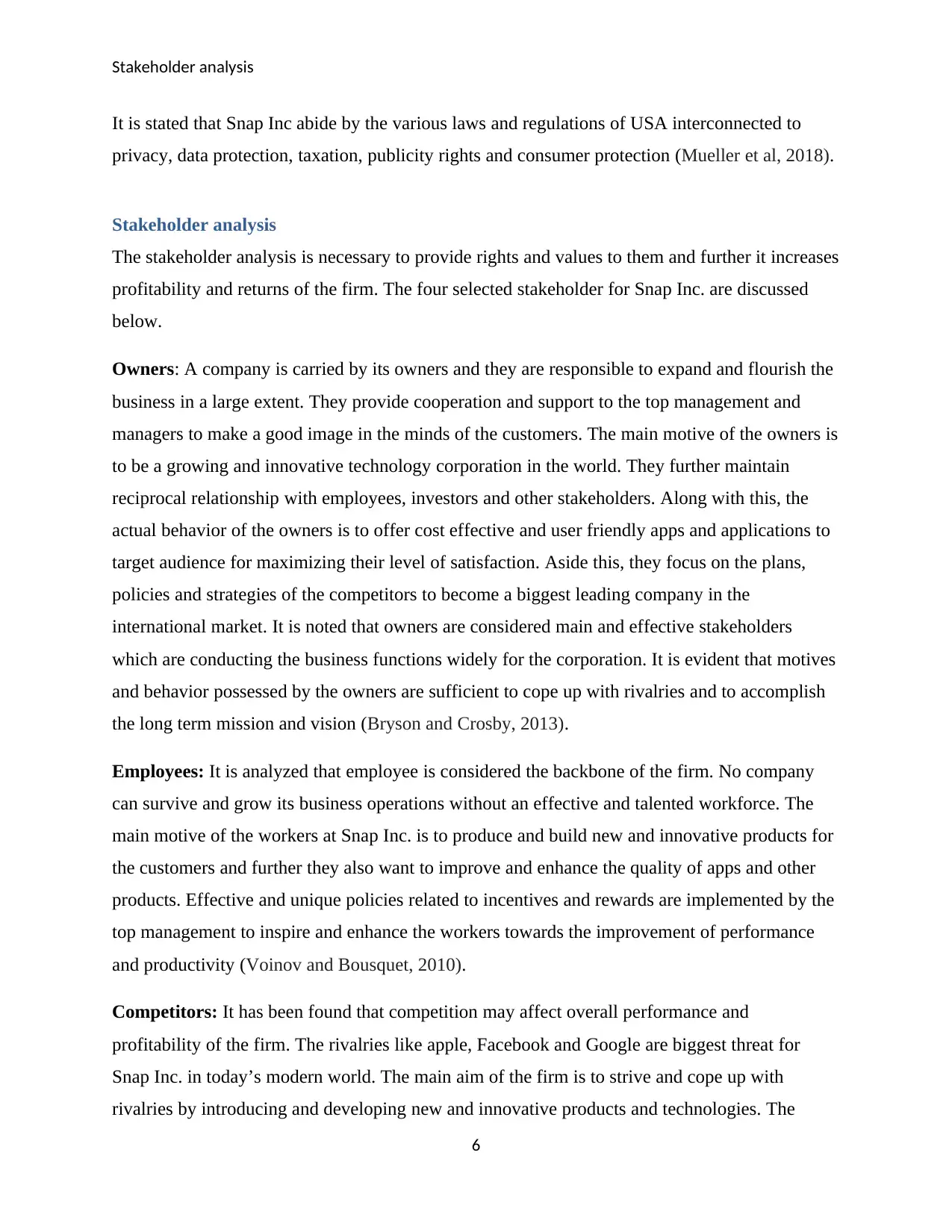
Stakeholder analysis
It is stated that Snap Inc abide by the various laws and regulations of USA interconnected to
privacy, data protection, taxation, publicity rights and consumer protection (Mueller et al, 2018).
Stakeholder analysis
The stakeholder analysis is necessary to provide rights and values to them and further it increases
profitability and returns of the firm. The four selected stakeholder for Snap Inc. are discussed
below.
Owners: A company is carried by its owners and they are responsible to expand and flourish the
business in a large extent. They provide cooperation and support to the top management and
managers to make a good image in the minds of the customers. The main motive of the owners is
to be a growing and innovative technology corporation in the world. They further maintain
reciprocal relationship with employees, investors and other stakeholders. Along with this, the
actual behavior of the owners is to offer cost effective and user friendly apps and applications to
target audience for maximizing their level of satisfaction. Aside this, they focus on the plans,
policies and strategies of the competitors to become a biggest leading company in the
international market. It is noted that owners are considered main and effective stakeholders
which are conducting the business functions widely for the corporation. It is evident that motives
and behavior possessed by the owners are sufficient to cope up with rivalries and to accomplish
the long term mission and vision (Bryson and Crosby, 2013).
Employees: It is analyzed that employee is considered the backbone of the firm. No company
can survive and grow its business operations without an effective and talented workforce. The
main motive of the workers at Snap Inc. is to produce and build new and innovative products for
the customers and further they also want to improve and enhance the quality of apps and other
products. Effective and unique policies related to incentives and rewards are implemented by the
top management to inspire and enhance the workers towards the improvement of performance
and productivity (Voinov and Bousquet, 2010).
Competitors: It has been found that competition may affect overall performance and
profitability of the firm. The rivalries like apple, Facebook and Google are biggest threat for
Snap Inc. in today’s modern world. The main aim of the firm is to strive and cope up with
rivalries by introducing and developing new and innovative products and technologies. The
6
It is stated that Snap Inc abide by the various laws and regulations of USA interconnected to
privacy, data protection, taxation, publicity rights and consumer protection (Mueller et al, 2018).
Stakeholder analysis
The stakeholder analysis is necessary to provide rights and values to them and further it increases
profitability and returns of the firm. The four selected stakeholder for Snap Inc. are discussed
below.
Owners: A company is carried by its owners and they are responsible to expand and flourish the
business in a large extent. They provide cooperation and support to the top management and
managers to make a good image in the minds of the customers. The main motive of the owners is
to be a growing and innovative technology corporation in the world. They further maintain
reciprocal relationship with employees, investors and other stakeholders. Along with this, the
actual behavior of the owners is to offer cost effective and user friendly apps and applications to
target audience for maximizing their level of satisfaction. Aside this, they focus on the plans,
policies and strategies of the competitors to become a biggest leading company in the
international market. It is noted that owners are considered main and effective stakeholders
which are conducting the business functions widely for the corporation. It is evident that motives
and behavior possessed by the owners are sufficient to cope up with rivalries and to accomplish
the long term mission and vision (Bryson and Crosby, 2013).
Employees: It is analyzed that employee is considered the backbone of the firm. No company
can survive and grow its business operations without an effective and talented workforce. The
main motive of the workers at Snap Inc. is to produce and build new and innovative products for
the customers and further they also want to improve and enhance the quality of apps and other
products. Effective and unique policies related to incentives and rewards are implemented by the
top management to inspire and enhance the workers towards the improvement of performance
and productivity (Voinov and Bousquet, 2010).
Competitors: It has been found that competition may affect overall performance and
profitability of the firm. The rivalries like apple, Facebook and Google are biggest threat for
Snap Inc. in today’s modern world. The main aim of the firm is to strive and cope up with
rivalries by introducing and developing new and innovative products and technologies. The
6
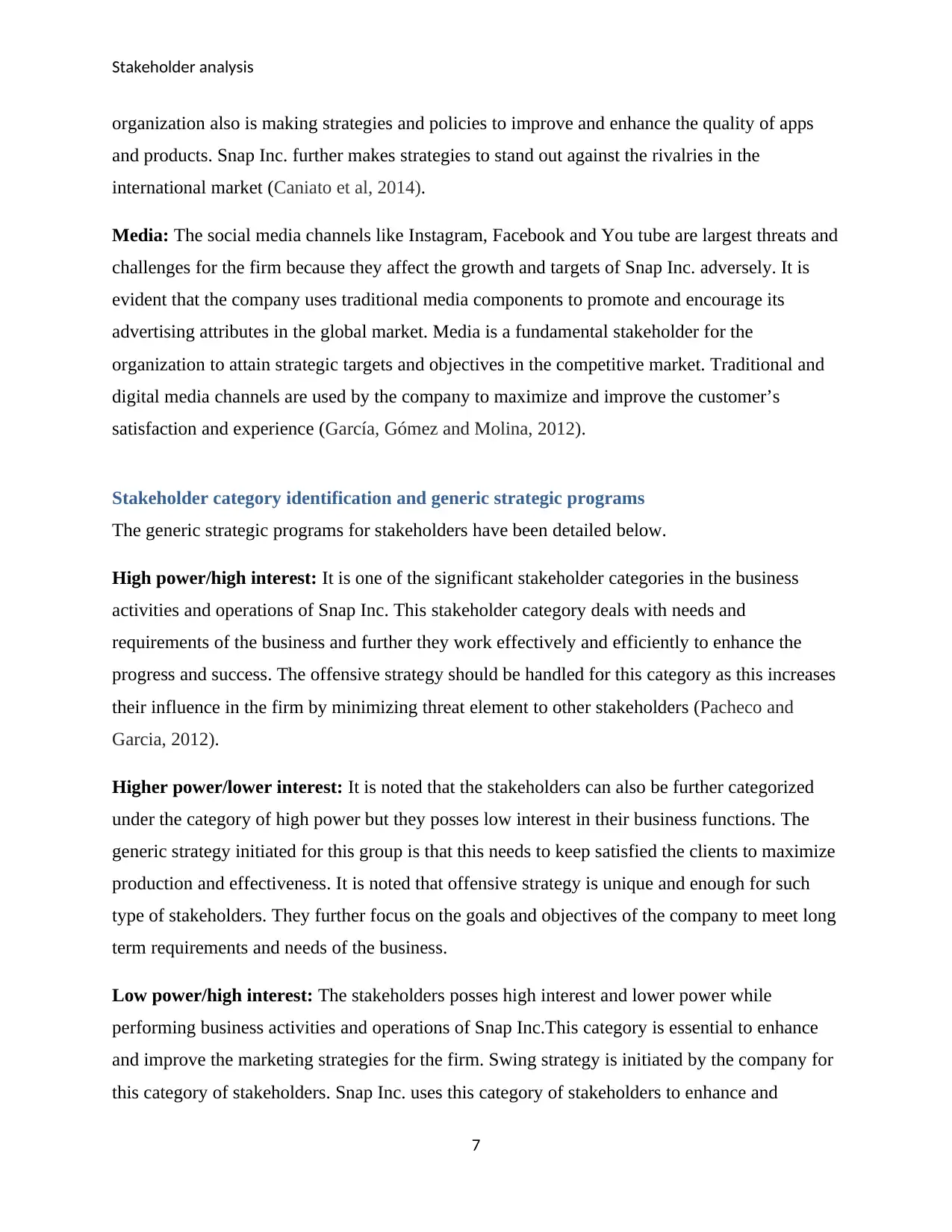
Stakeholder analysis
organization also is making strategies and policies to improve and enhance the quality of apps
and products. Snap Inc. further makes strategies to stand out against the rivalries in the
international market (Caniato et al, 2014).
Media: The social media channels like Instagram, Facebook and You tube are largest threats and
challenges for the firm because they affect the growth and targets of Snap Inc. adversely. It is
evident that the company uses traditional media components to promote and encourage its
advertising attributes in the global market. Media is a fundamental stakeholder for the
organization to attain strategic targets and objectives in the competitive market. Traditional and
digital media channels are used by the company to maximize and improve the customer’s
satisfaction and experience (García, Gómez and Molina, 2012).
Stakeholder category identification and generic strategic programs
The generic strategic programs for stakeholders have been detailed below.
High power/high interest: It is one of the significant stakeholder categories in the business
activities and operations of Snap Inc. This stakeholder category deals with needs and
requirements of the business and further they work effectively and efficiently to enhance the
progress and success. The offensive strategy should be handled for this category as this increases
their influence in the firm by minimizing threat element to other stakeholders (Pacheco and
Garcia, 2012).
Higher power/lower interest: It is noted that the stakeholders can also be further categorized
under the category of high power but they posses low interest in their business functions. The
generic strategy initiated for this group is that this needs to keep satisfied the clients to maximize
production and effectiveness. It is noted that offensive strategy is unique and enough for such
type of stakeholders. They further focus on the goals and objectives of the company to meet long
term requirements and needs of the business.
Low power/high interest: The stakeholders posses high interest and lower power while
performing business activities and operations of Snap Inc.This category is essential to enhance
and improve the marketing strategies for the firm. Swing strategy is initiated by the company for
this category of stakeholders. Snap Inc. uses this category of stakeholders to enhance and
7
organization also is making strategies and policies to improve and enhance the quality of apps
and products. Snap Inc. further makes strategies to stand out against the rivalries in the
international market (Caniato et al, 2014).
Media: The social media channels like Instagram, Facebook and You tube are largest threats and
challenges for the firm because they affect the growth and targets of Snap Inc. adversely. It is
evident that the company uses traditional media components to promote and encourage its
advertising attributes in the global market. Media is a fundamental stakeholder for the
organization to attain strategic targets and objectives in the competitive market. Traditional and
digital media channels are used by the company to maximize and improve the customer’s
satisfaction and experience (García, Gómez and Molina, 2012).
Stakeholder category identification and generic strategic programs
The generic strategic programs for stakeholders have been detailed below.
High power/high interest: It is one of the significant stakeholder categories in the business
activities and operations of Snap Inc. This stakeholder category deals with needs and
requirements of the business and further they work effectively and efficiently to enhance the
progress and success. The offensive strategy should be handled for this category as this increases
their influence in the firm by minimizing threat element to other stakeholders (Pacheco and
Garcia, 2012).
Higher power/lower interest: It is noted that the stakeholders can also be further categorized
under the category of high power but they posses low interest in their business functions. The
generic strategy initiated for this group is that this needs to keep satisfied the clients to maximize
production and effectiveness. It is noted that offensive strategy is unique and enough for such
type of stakeholders. They further focus on the goals and objectives of the company to meet long
term requirements and needs of the business.
Low power/high interest: The stakeholders posses high interest and lower power while
performing business activities and operations of Snap Inc.This category is essential to enhance
and improve the marketing strategies for the firm. Swing strategy is initiated by the company for
this category of stakeholders. Snap Inc. uses this category of stakeholders to enhance and
7
Paraphrase This Document
Need a fresh take? Get an instant paraphrase of this document with our AI Paraphraser
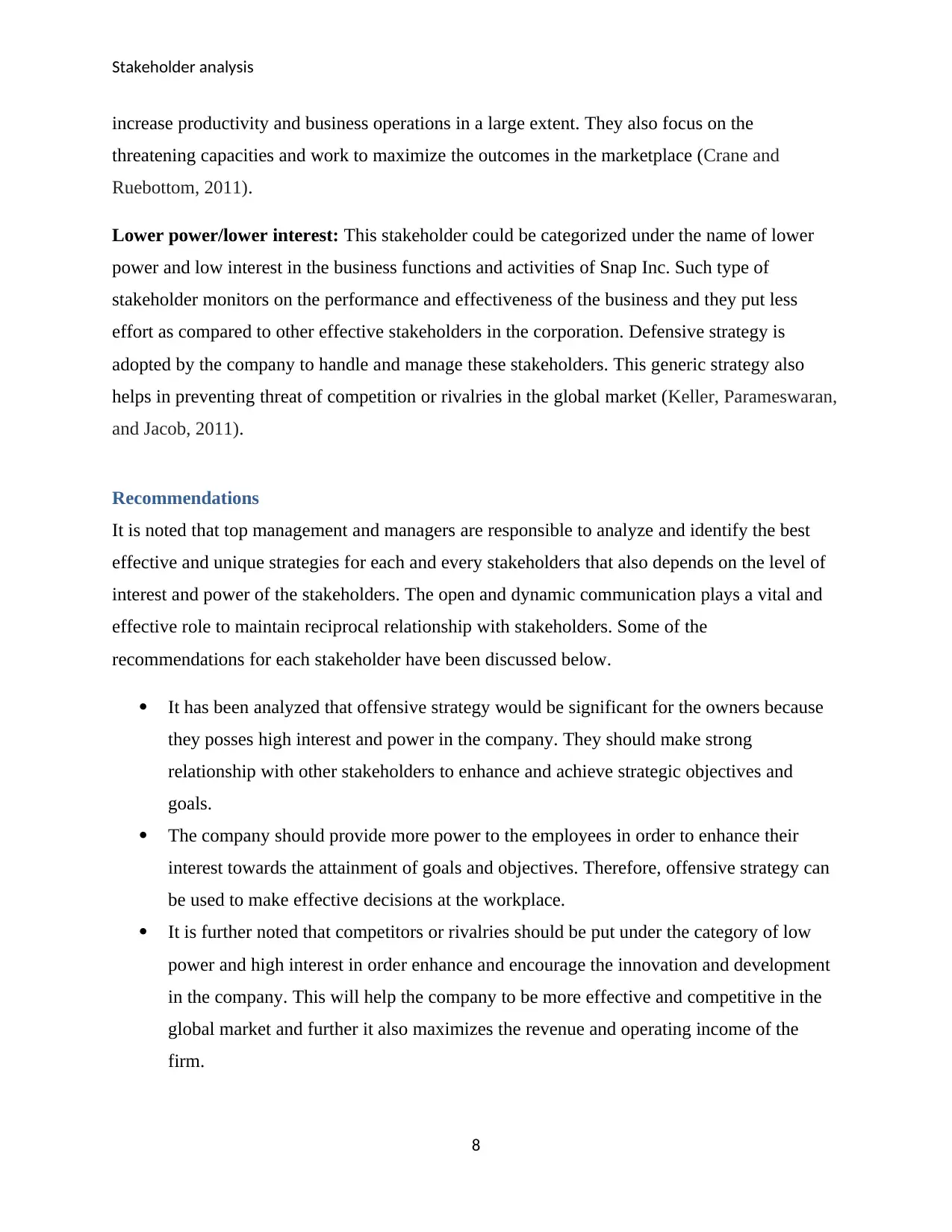
Stakeholder analysis
increase productivity and business operations in a large extent. They also focus on the
threatening capacities and work to maximize the outcomes in the marketplace (Crane and
Ruebottom, 2011).
Lower power/lower interest: This stakeholder could be categorized under the name of lower
power and low interest in the business functions and activities of Snap Inc. Such type of
stakeholder monitors on the performance and effectiveness of the business and they put less
effort as compared to other effective stakeholders in the corporation. Defensive strategy is
adopted by the company to handle and manage these stakeholders. This generic strategy also
helps in preventing threat of competition or rivalries in the global market (Keller, Parameswaran,
and Jacob, 2011).
Recommendations
It is noted that top management and managers are responsible to analyze and identify the best
effective and unique strategies for each and every stakeholders that also depends on the level of
interest and power of the stakeholders. The open and dynamic communication plays a vital and
effective role to maintain reciprocal relationship with stakeholders. Some of the
recommendations for each stakeholder have been discussed below.
It has been analyzed that offensive strategy would be significant for the owners because
they posses high interest and power in the company. They should make strong
relationship with other stakeholders to enhance and achieve strategic objectives and
goals.
The company should provide more power to the employees in order to enhance their
interest towards the attainment of goals and objectives. Therefore, offensive strategy can
be used to make effective decisions at the workplace.
It is further noted that competitors or rivalries should be put under the category of low
power and high interest in order enhance and encourage the innovation and development
in the company. This will help the company to be more effective and competitive in the
global market and further it also maximizes the revenue and operating income of the
firm.
8
increase productivity and business operations in a large extent. They also focus on the
threatening capacities and work to maximize the outcomes in the marketplace (Crane and
Ruebottom, 2011).
Lower power/lower interest: This stakeholder could be categorized under the name of lower
power and low interest in the business functions and activities of Snap Inc. Such type of
stakeholder monitors on the performance and effectiveness of the business and they put less
effort as compared to other effective stakeholders in the corporation. Defensive strategy is
adopted by the company to handle and manage these stakeholders. This generic strategy also
helps in preventing threat of competition or rivalries in the global market (Keller, Parameswaran,
and Jacob, 2011).
Recommendations
It is noted that top management and managers are responsible to analyze and identify the best
effective and unique strategies for each and every stakeholders that also depends on the level of
interest and power of the stakeholders. The open and dynamic communication plays a vital and
effective role to maintain reciprocal relationship with stakeholders. Some of the
recommendations for each stakeholder have been discussed below.
It has been analyzed that offensive strategy would be significant for the owners because
they posses high interest and power in the company. They should make strong
relationship with other stakeholders to enhance and achieve strategic objectives and
goals.
The company should provide more power to the employees in order to enhance their
interest towards the attainment of goals and objectives. Therefore, offensive strategy can
be used to make effective decisions at the workplace.
It is further noted that competitors or rivalries should be put under the category of low
power and high interest in order enhance and encourage the innovation and development
in the company. This will help the company to be more effective and competitive in the
global market and further it also maximizes the revenue and operating income of the
firm.
8
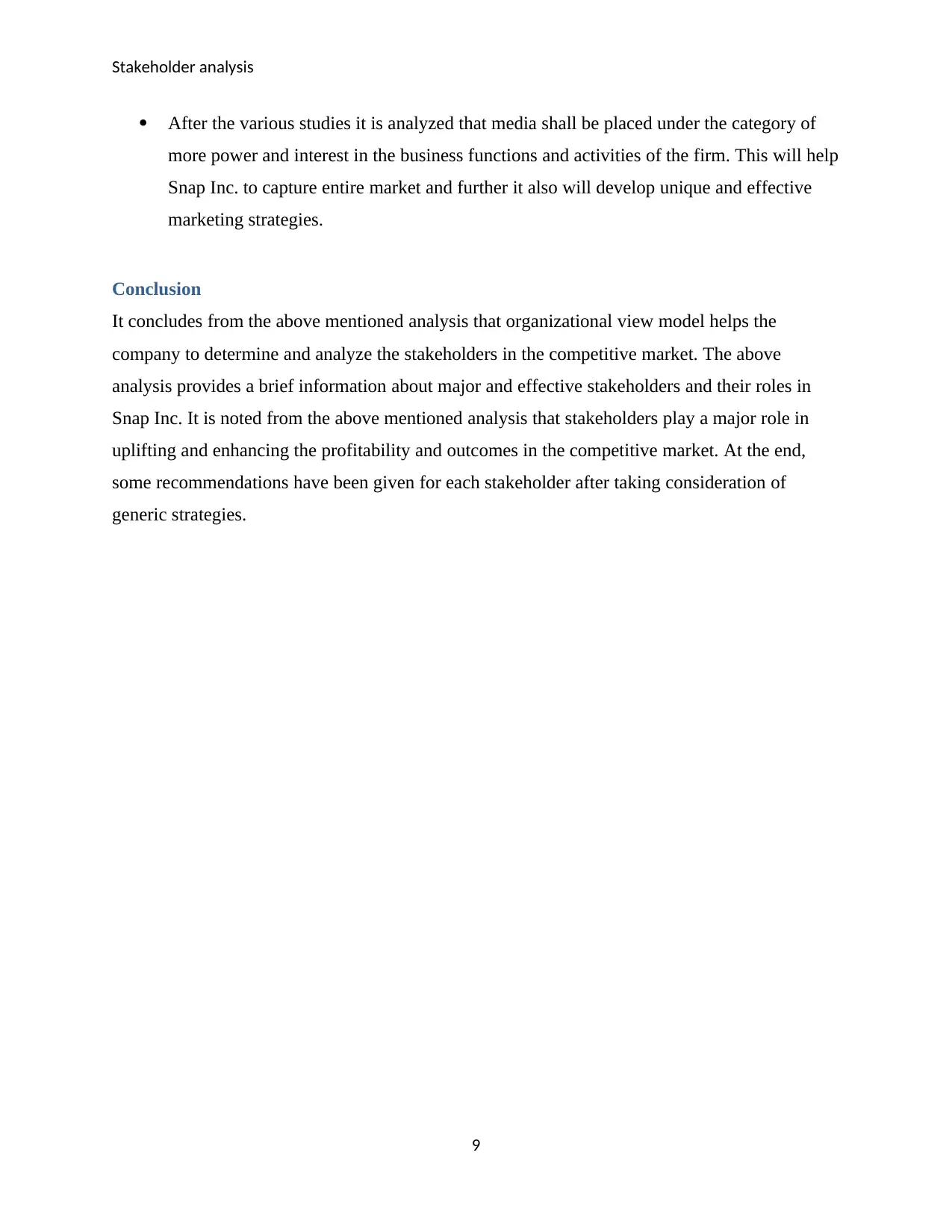
Stakeholder analysis
After the various studies it is analyzed that media shall be placed under the category of
more power and interest in the business functions and activities of the firm. This will help
Snap Inc. to capture entire market and further it also will develop unique and effective
marketing strategies.
Conclusion
It concludes from the above mentioned analysis that organizational view model helps the
company to determine and analyze the stakeholders in the competitive market. The above
analysis provides a brief information about major and effective stakeholders and their roles in
Snap Inc. It is noted from the above mentioned analysis that stakeholders play a major role in
uplifting and enhancing the profitability and outcomes in the competitive market. At the end,
some recommendations have been given for each stakeholder after taking consideration of
generic strategies.
9
After the various studies it is analyzed that media shall be placed under the category of
more power and interest in the business functions and activities of the firm. This will help
Snap Inc. to capture entire market and further it also will develop unique and effective
marketing strategies.
Conclusion
It concludes from the above mentioned analysis that organizational view model helps the
company to determine and analyze the stakeholders in the competitive market. The above
analysis provides a brief information about major and effective stakeholders and their roles in
Snap Inc. It is noted from the above mentioned analysis that stakeholders play a major role in
uplifting and enhancing the profitability and outcomes in the competitive market. At the end,
some recommendations have been given for each stakeholder after taking consideration of
generic strategies.
9
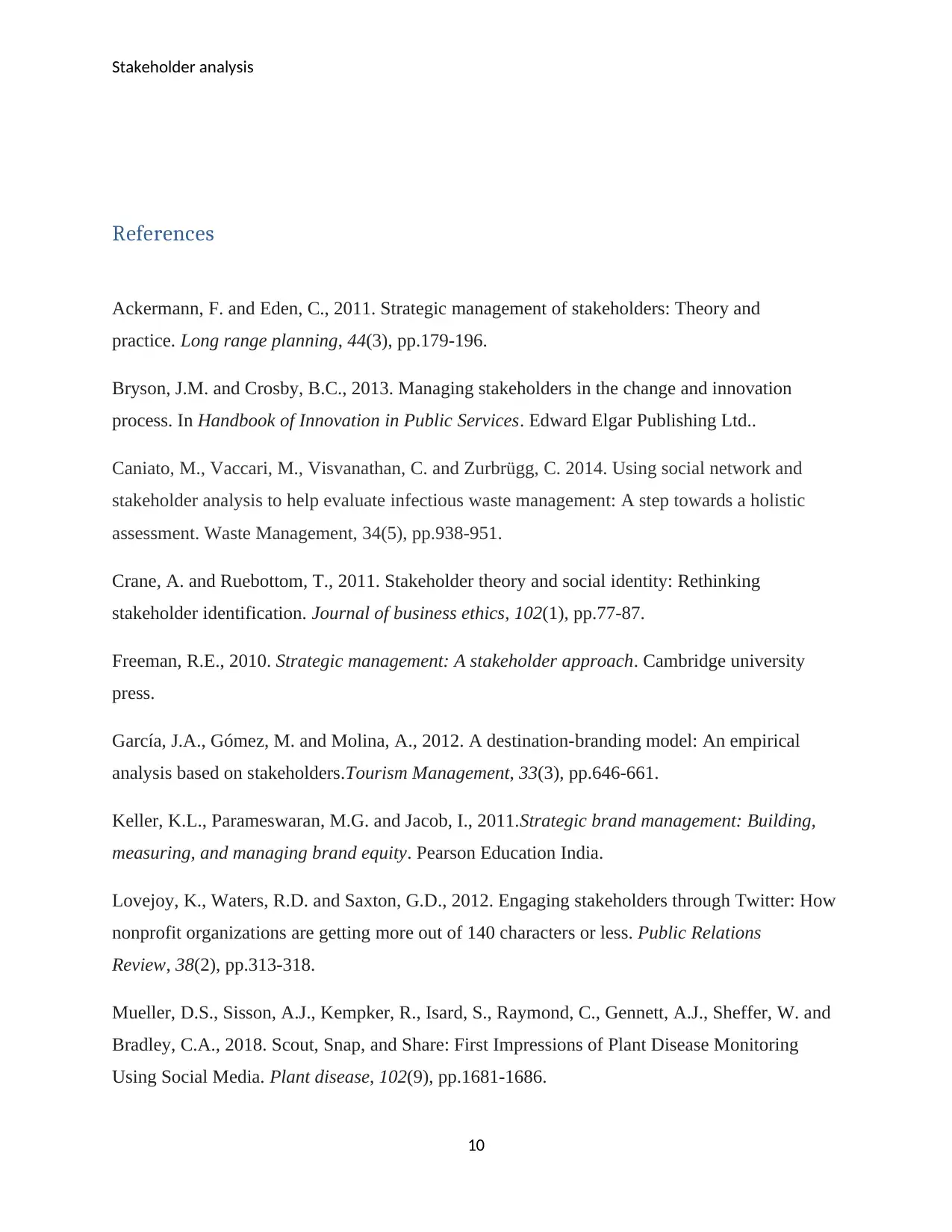
Stakeholder analysis
References
Ackermann, F. and Eden, C., 2011. Strategic management of stakeholders: Theory and
practice. Long range planning, 44(3), pp.179-196.
Bryson, J.M. and Crosby, B.C., 2013. Managing stakeholders in the change and innovation
process. In Handbook of Innovation in Public Services. Edward Elgar Publishing Ltd..
Caniato, M., Vaccari, M., Visvanathan, C. and Zurbrügg, C. 2014. Using social network and
stakeholder analysis to help evaluate infectious waste management: A step towards a holistic
assessment. Waste Management, 34(5), pp.938-951.
Crane, A. and Ruebottom, T., 2011. Stakeholder theory and social identity: Rethinking
stakeholder identification. Journal of business ethics, 102(1), pp.77-87.
Freeman, R.E., 2010. Strategic management: A stakeholder approach. Cambridge university
press.
García, J.A., Gómez, M. and Molina, A., 2012. A destination-branding model: An empirical
analysis based on stakeholders.Tourism Management, 33(3), pp.646-661.
Keller, K.L., Parameswaran, M.G. and Jacob, I., 2011.Strategic brand management: Building,
measuring, and managing brand equity. Pearson Education India.
Lovejoy, K., Waters, R.D. and Saxton, G.D., 2012. Engaging stakeholders through Twitter: How
nonprofit organizations are getting more out of 140 characters or less. Public Relations
Review, 38(2), pp.313-318.
Mueller, D.S., Sisson, A.J., Kempker, R., Isard, S., Raymond, C., Gennett, A.J., Sheffer, W. and
Bradley, C.A., 2018. Scout, Snap, and Share: First Impressions of Plant Disease Monitoring
Using Social Media. Plant disease, 102(9), pp.1681-1686.
10
References
Ackermann, F. and Eden, C., 2011. Strategic management of stakeholders: Theory and
practice. Long range planning, 44(3), pp.179-196.
Bryson, J.M. and Crosby, B.C., 2013. Managing stakeholders in the change and innovation
process. In Handbook of Innovation in Public Services. Edward Elgar Publishing Ltd..
Caniato, M., Vaccari, M., Visvanathan, C. and Zurbrügg, C. 2014. Using social network and
stakeholder analysis to help evaluate infectious waste management: A step towards a holistic
assessment. Waste Management, 34(5), pp.938-951.
Crane, A. and Ruebottom, T., 2011. Stakeholder theory and social identity: Rethinking
stakeholder identification. Journal of business ethics, 102(1), pp.77-87.
Freeman, R.E., 2010. Strategic management: A stakeholder approach. Cambridge university
press.
García, J.A., Gómez, M. and Molina, A., 2012. A destination-branding model: An empirical
analysis based on stakeholders.Tourism Management, 33(3), pp.646-661.
Keller, K.L., Parameswaran, M.G. and Jacob, I., 2011.Strategic brand management: Building,
measuring, and managing brand equity. Pearson Education India.
Lovejoy, K., Waters, R.D. and Saxton, G.D., 2012. Engaging stakeholders through Twitter: How
nonprofit organizations are getting more out of 140 characters or less. Public Relations
Review, 38(2), pp.313-318.
Mueller, D.S., Sisson, A.J., Kempker, R., Isard, S., Raymond, C., Gennett, A.J., Sheffer, W. and
Bradley, C.A., 2018. Scout, Snap, and Share: First Impressions of Plant Disease Monitoring
Using Social Media. Plant disease, 102(9), pp.1681-1686.
10
Secure Best Marks with AI Grader
Need help grading? Try our AI Grader for instant feedback on your assignments.
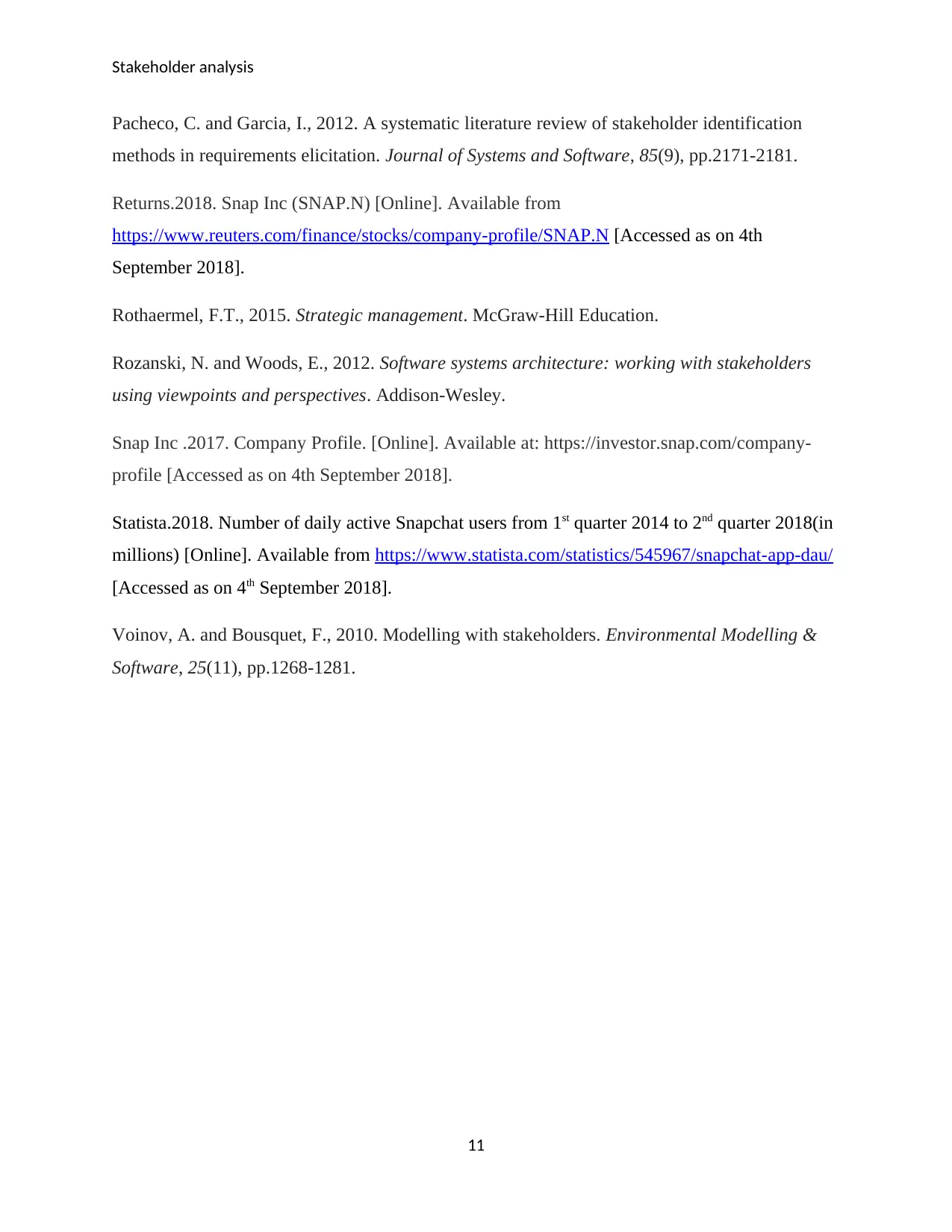
Stakeholder analysis
Pacheco, C. and Garcia, I., 2012. A systematic literature review of stakeholder identification
methods in requirements elicitation. Journal of Systems and Software, 85(9), pp.2171-2181.
Returns.2018. Snap Inc (SNAP.N) [Online]. Available from
https://www.reuters.com/finance/stocks/company-profile/SNAP.N [Accessed as on 4th
September 2018].
Rothaermel, F.T., 2015. Strategic management. McGraw-Hill Education.
Rozanski, N. and Woods, E., 2012. Software systems architecture: working with stakeholders
using viewpoints and perspectives. Addison-Wesley.
Snap Inc .2017. Company Profile. [Online]. Available at: https://investor.snap.com/company-
profile [Accessed as on 4th September 2018].
Statista.2018. Number of daily active Snapchat users from 1st quarter 2014 to 2nd quarter 2018(in
millions) [Online]. Available from https://www.statista.com/statistics/545967/snapchat-app-dau/
[Accessed as on 4th September 2018].
Voinov, A. and Bousquet, F., 2010. Modelling with stakeholders. Environmental Modelling &
Software, 25(11), pp.1268-1281.
11
Pacheco, C. and Garcia, I., 2012. A systematic literature review of stakeholder identification
methods in requirements elicitation. Journal of Systems and Software, 85(9), pp.2171-2181.
Returns.2018. Snap Inc (SNAP.N) [Online]. Available from
https://www.reuters.com/finance/stocks/company-profile/SNAP.N [Accessed as on 4th
September 2018].
Rothaermel, F.T., 2015. Strategic management. McGraw-Hill Education.
Rozanski, N. and Woods, E., 2012. Software systems architecture: working with stakeholders
using viewpoints and perspectives. Addison-Wesley.
Snap Inc .2017. Company Profile. [Online]. Available at: https://investor.snap.com/company-
profile [Accessed as on 4th September 2018].
Statista.2018. Number of daily active Snapchat users from 1st quarter 2014 to 2nd quarter 2018(in
millions) [Online]. Available from https://www.statista.com/statistics/545967/snapchat-app-dau/
[Accessed as on 4th September 2018].
Voinov, A. and Bousquet, F., 2010. Modelling with stakeholders. Environmental Modelling &
Software, 25(11), pp.1268-1281.
11
1 out of 11
Related Documents
Your All-in-One AI-Powered Toolkit for Academic Success.
+13062052269
info@desklib.com
Available 24*7 on WhatsApp / Email
![[object Object]](/_next/static/media/star-bottom.7253800d.svg)
Unlock your academic potential
© 2024 | Zucol Services PVT LTD | All rights reserved.





